Discovering Verona
Pronti Partenza Via, returns with its documentary series to show you and describe the most beautiful Italian cities darte. Verona is certainly one of the most visited and among the best known in the world, perhaps because of its name linked to the Shakespearean tragedy Juliet & Romeo, or perhaps because of its many monuments from the past that make it appear as the most Roman city in Italy after Rome.
Certainly the Romans identified the plain at the mouth of the Valle dellAdige as a strategic point of considerable importance at which to build a city that would be focal for controlling transits to Europe. Thus was born the city, in a happy geographical position, equipped with every comfort and spaces for daily life of which at least two remain evident today: the theater and lanfiteatro. The image of Verona is inextricably linked to its Arena, which, even today, continues to fulfill its function as a container for performances. Only the genre has changed, from gladiator and animal fights to more refined and no less grandiose musical performances, including the important opera season. The theater also continues to be a venue for summer performances, recently renovated along with the Archaeological Museum complex, of which it forms a unique pole with a superb view of the city and the Adige River.
 |
| Interior of the Arena of Verona |
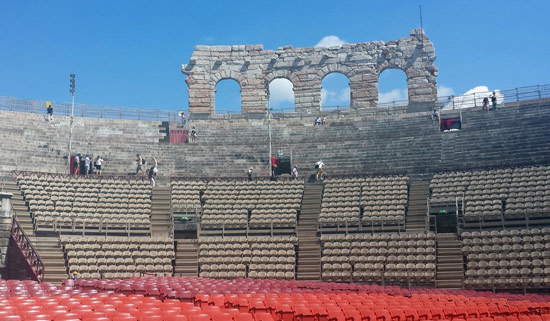 |
| The wing of the Arena of Verona |
If theArena is the symbol of Roman Verona, in the Middle Ages the city became linked to another emblem, that of the Scaligeri family who knew how to restore luster and prestige to the city after a period of decline during the barbarian invasions. With the patronage of Cangrande della Scala, Verona began to embellish itself with notable monuments and works dArte: from that period today the city preserves squares and palaces built by the resident noble families. Among these families were the Del Cappello or Capuleti, whose young daughter Juliet fell madly in love with Romeo, scion of the rival Montecchi family. The novella by Luigi da Porto from Vicenza tells this story, which ends with the death of the two lovers; William Shakespeare taking his cue from the tale wrote his famous drama, which can still be relived today by visiting these places: the house of Juliet with the balcony, the house of Romeo and Juliet’s tomb.
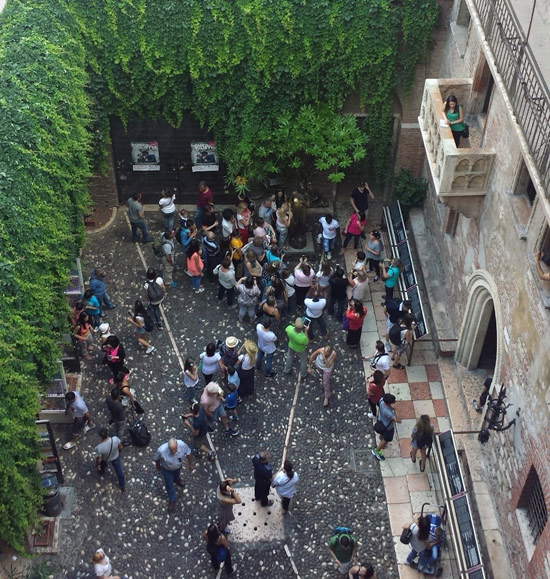 |
| Juliet’s house |
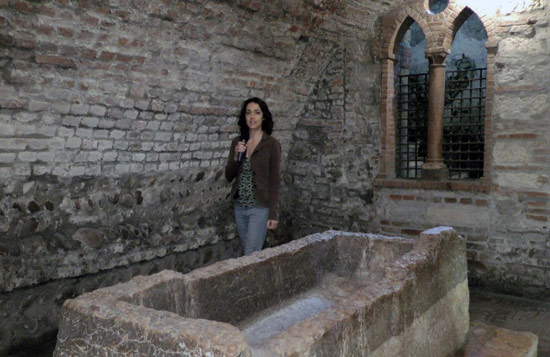 |
| Juliet’s Tomb |
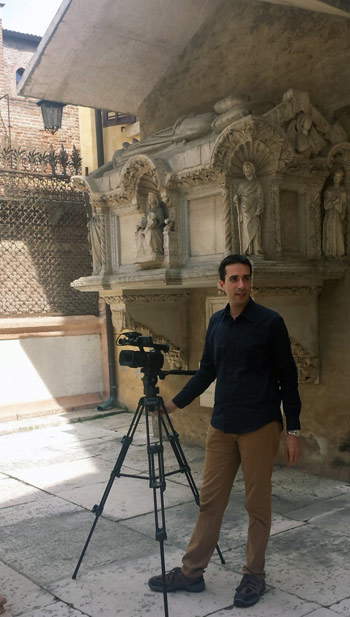 |
| Fabrizio at the Arche Scaligere |
The city tour continues through its two main squares, as in every Venetian city, Piazza delle Erbe (at the site of the Roman forum, the square historically used for the market), Piazza dei Signori (on which the places of power overlooked) with the Palazzo del Governo, the Palazzo del Capitano, the Loggia del Consiglio, and the Palazzo della Ragione topped by the lofty Lamberti tower, from which there is a 360-degree view of the city from above. Not far away are the Scaliger arches, the majestic tombs of the Scaligeri.
Not to be overlooked are the city’s churches starting with the Romanesque Basilica of San Zeno Maggiore, with its facade carved in stone, the famous <a href=’https://www.finestresullarte.info/353n_andrea-mantegna-pala-di-san-zeno-rinascimento-veronese.php’ target=’_blank’>pala by Andrea Mantegna</a>, its cloister and crypt where the remains of Bishop Zeno are kept. The gothic SantAnastasia preserves numerous wall frescoes and two very special stoups called hunchbacks.Finally, the cathedral stands on the site of an earlier basilica, the remains of which remain together with the remains of two other churches, which can be visited by accessing the apse part of the cathedral. I recommend its visit.</p> <p> From the museum point of view there are many city setups, in addition to the aforementioned Archaeological Museum, there is the interesting Museo Maffeiano (in Piazza Bra) that collects inscriptions and epigraphs and the Museo degli Affreschi at Juliet’s tomb with a series of frescoes detached from the facades of city palaces and some churches.</p> <p>The most important museum in the Veneto region can be considered <a href=’https://www.finestresullarte.info/musei-d-italia/2012/09-museo-castelvecchio-verona.php’ target=’_blank’>Castelvecchio</a>, set up by architect Carlo Scarpa in the Scaliger castle on the banks of the Adige River. Inside the castle, a museum tour spans several centuries of history, which can be explored through a sculptural, numismatic and finally pictorial section. The rich picture gallery displays works by the most important artists from Veneto and beyond, some names: Altichieri, Bellini, Caroto, Carpaccio, Falconetto, Mantegna, Morone, Pisanello, Tintoretto, Turone, Veronese, and Vivarini.</p> <p style=’text-align:center’> <table class=’image-ilaria’><tr><td><img src=’https://cdn.finestresullarte.info/rivista/immagini/2016/557/piazza-delle-erbe.jpg’ alt=“Piazza delle Erbe dall’alto” title=“Piazza delle Erbe dall’alto” /></td></tr><tr><td>Piazza delle Erbe dall’alto
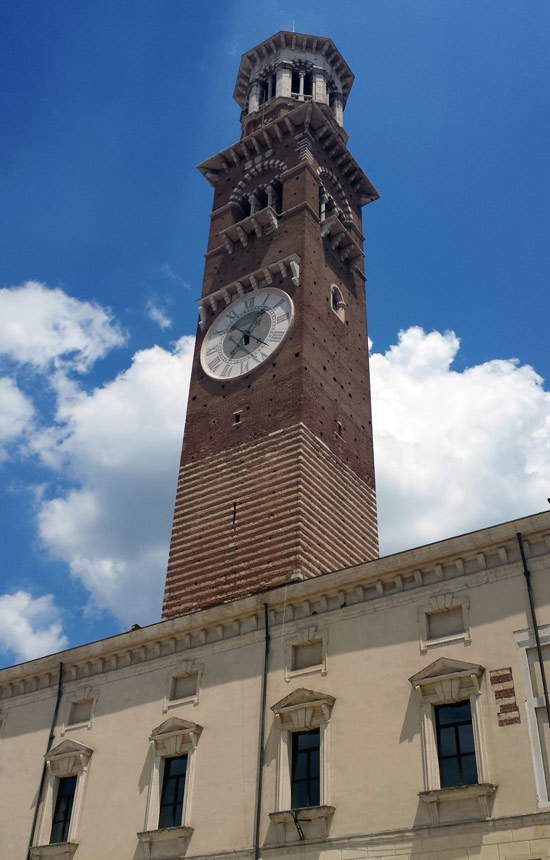 |
| The Lamberti Tower |
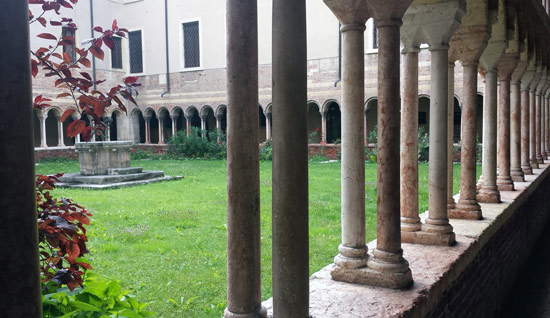 |
| The cloister of the canons |
The cultural richness offered by Verona along with its prestigious monuments has earned the city UNESCO recognition, placing it on the World Heritage List. There are many Italian cities that boast of this recognition making Italy the Nation with the largest number of UNESCO sites in the World. We can be proud of this.
For those who would like to take a last look before leaving Verona, I invite you to climb the hill of Castel San Pietro where you can linger and observe the city of lovers at sunset, perhaps in pleasant company. Enjoy your trip, see you next time!
A few questions to test your preparation about Verona.
Question 1: What does the magistracy Conservatores Arenae deal with?
Question 2: How come there is a statue of Dante in Piazza dei Signori?
Question 3: What are the Rengo and the Marangona?
Warning: the translation into English of the original Italian article was created using automatic tools. We undertake to review all articles, but we do not guarantee the total absence of inaccuracies in the translation due to the program. You can find the original by clicking on the ITA button. If you find any mistake,please contact us.





























